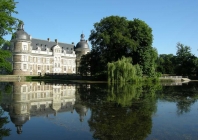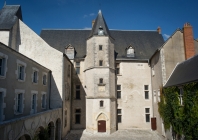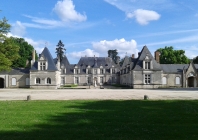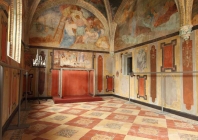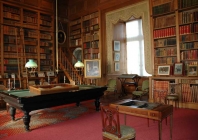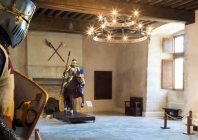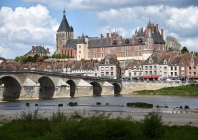The Loire Valley has more than 1000 castles!
It’s impossible to make a complete list but we strive to offer you a maximum.
Here is a list of castles of the Loire Valley that it is possible to discover on request.
Villesavin:
The castle was built by Jean le Breton between 1527-1537 on the site of an old manor. He was entrusted by King François 1st with the task and controlling of the building and paying of Chambord.
In appreciation, Jean le Breton disposed of Villesavin’s lands to build his manor, which later gave it the nickname of “the construction site cabin”.
Troussay:
Known as the smallest of the château of the Loire, its story begins with its construction around 1450. His first known owner was Robert de Buggy, an equerry of François I.
This castle gathered a variety of elements integrated into the architectures as well as a wealth of furniture from different centuries.
Several gardens with a rich collection of essences (Cedar of Lebanon and Virginia, sequoias of America…), a French garden and a kitchen garden from the 8th century. There is also a small regional eco-museum representing the “solognot” way of life.
Férté Saint Aubin:
Located in the center of Sologne, this castle is surrounded by water moats and rises in the edges of the Cosson river in a magnificent 40-acres parc.
Its construction spread through three periods; the first one began at the end of the XVI century with Henri I de la Ferté Sennectère.
Later on, his son Henri II de la Ferte Sennectère will continue with the building of the two stables.
The construction will be complete in 1746 by Wolfemar Count of Lowendal and Maréchal de France.
The impressive chapel located behind the castle was built by Madam Dessales at the end of the 19th century.
Gien:
The actual castle as we know it was created in 1482 on the spot of an old medieval fortress, thus by the demand of Anne de Beaujeu.
Its decorative architecture with red and black bricks gives it a peculiar Renaissance aspect.
In 1407 Charles d’Orléans formed an alliance with his uncle the Duke of Berry, his cousin the duke of Bourbon and the Duke of Brittany.
In 1410 the Treaty of Gien was signed against the Duke of Burgundy Fearless John, whom had ordered the assassination of the Duke Louis of Orleans, brother of Charles VI.
Joan of Arc, Charles II, François 1st, Catherine of Medicis, Charles IX, Louis XIV and Anne d’Autriche stayed there as well.
The castle houses a hunting museum with an exceptional collection which includes pictoral works of Alexander François Desportes, painter of the hunting expeditions of Louis XIV.
Montgeoffroy:
Built by the Marquis of Contades, Marshal of France under Louis XV, the castle of Montgeoffroy represents the typical architecture of the end of the 8th century.
It was imagines by Vincent Barré, Parisian architect, between 1772 and 1776.
It is still furnished and decorated with its original furniture, tapestries and paintings. During the 13th century it belonged to Lord Geoffroy de Châteaubriand, ancestor of the famous Romantic writer.
Champchevrier:
This renaissance castle was built on the foundations of a former fortress during the XVIth century. A hundred years later, a classic style castle was added.
To this day, it is still inhabited by the same family.
Louis 8th was the first royal member to attend when he was 18 years old.
A fox hunting heritage is also represented with one of the oldest french crews.
Beaugency:
Seigneurial mansion which was successively the property of the Lords of Beaugency, the French Crown qnd the Dukes of Orleqns between the XIVth qnd the French Revolution. Today it opens its doors to the residence of Jean Dunois, Bastard or Orleans.
Francois 1st, Louis XI and Joan of Arc stayed there as well.
Jallanges:
Built on a former 1212 fortress in 1465 by Louis XI, the château de Jallanges was the home of his Prime Minister.
It was also owned by King’s Ministers, Prime Ministers, Queens Charlotte and Claude of France and also Marie Gaudin (favourite mistress of François 1st and grandmother of Gabrielle d’Estrée favourite of Henri II).
It was elected as a Châtellenie in 1631.
Lavardin:
With its Roman dungeon of the XIIth century and its medieval castle of the XIV. The castle of Lavardin welcomed Agnes Sorel and Charles VII.
It was dismantled by Henry IV at the end of the XVI and then plundered by villagers.
As for today, a dungeon, a drawbridge and other ruins are the testimony of its former glory.
Châteaudun:
Built between the 15th and 16th century on an old medieval fortress whose dungeon (built between 1170 and 1190) is today the trace, the château de Châteaudun is weel known for its gothic aspect.
It became a fortress during the 10th century and the construction of the chapel began in 1451.
It is in 1439 that Jean d’Orléans, Count of Dunois, son of Louis D’Orléans and Mariette D’Enghien, also known as “The Bastard of Orleans” received Châteaudun and the county of Dunnois from his brother.
Serrant:
After his return from the Italy wars, Péan de Brie decided to give thif former medieval fortress a Renaissance aspect.
But due to financial problems, the works are never finished.
Classicism – Guillaume de Bautru bought the place in 1636 and decided to resume the refection according the original architectural plans from the 16th century. The main building, south tower, two wings and two lodges are done.
In 1749, the castle was bought by the Walsh family, who exiled to France in loyalty to the Stuarts. Thanks to them, Châteaudun avoid destructions during the French Revolution.
The castle hosted some famous figures of History such as Archiduchess Maria Christina of Austria (Marie Antoinette’ sister), Napoleon I and Jospehine and Louis Napoleon Bonaparte.
Chamerolles:
Medieval fortress built in the first half of the 16th century by Lancelot I du Lac, Governor of Auxerre and King’s butler. In 1562, Lancelot II turns to Protestantism and converts the chapel to a temple.
François stayed here twice, in 1530 and in 1532 on his journey between Chambord and Fontainebleau.
Vaujours:
In the heart of a lush greenery, the 15th century medieval ruins of the castle of Vaujours are a witness to its existence. There are, the remains of the seigniorial dwelling, dungeons and the chapel.








